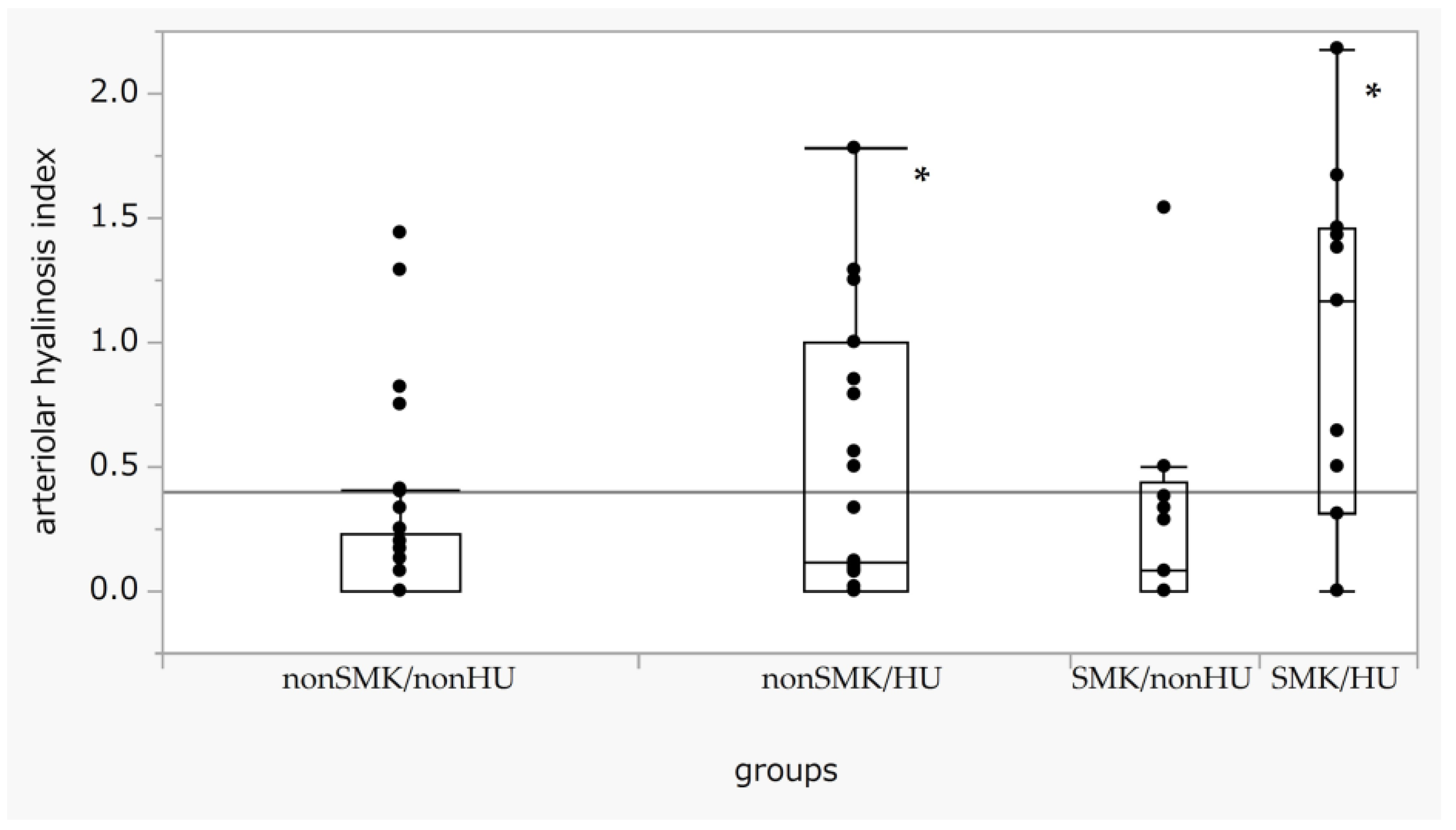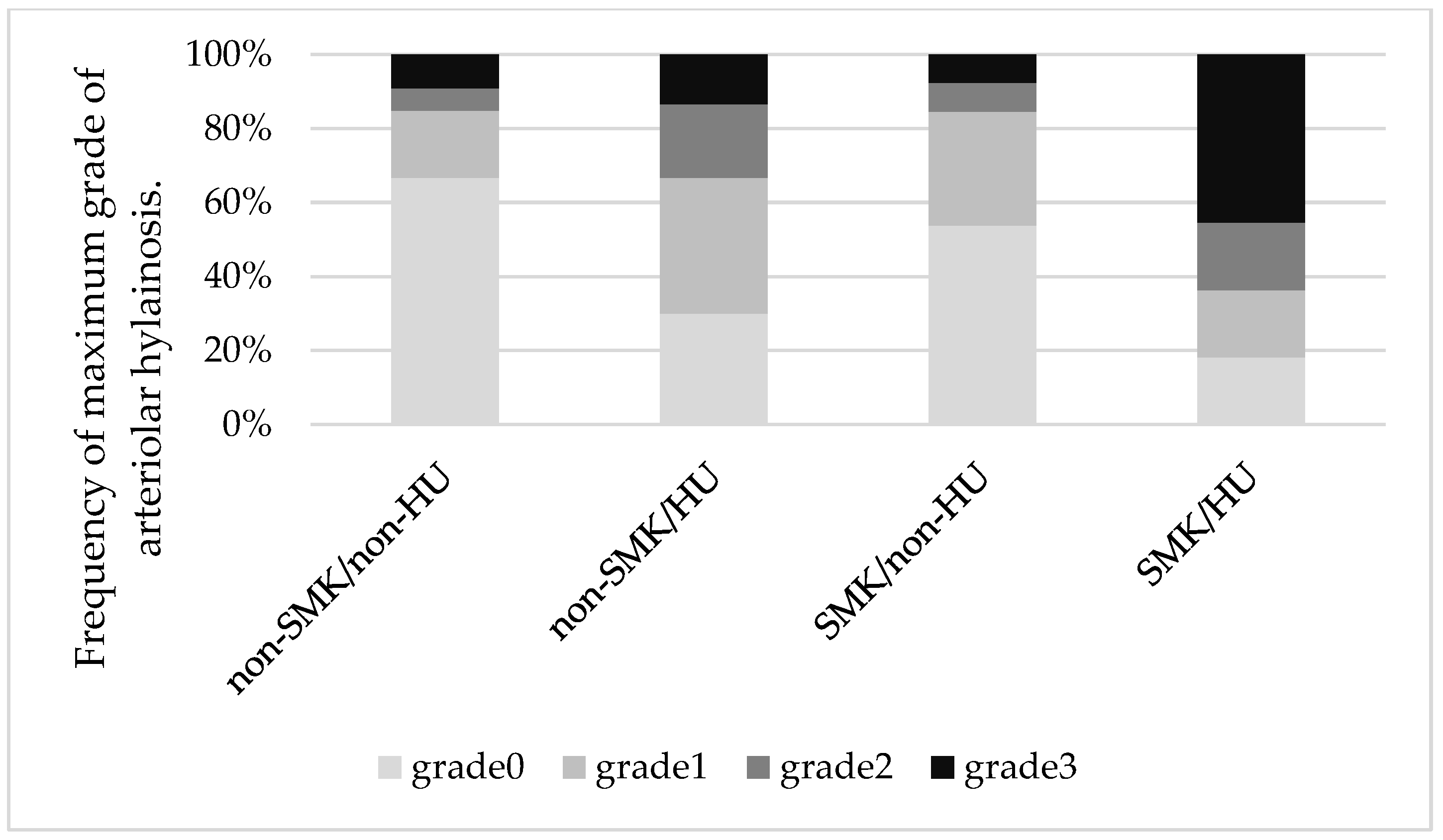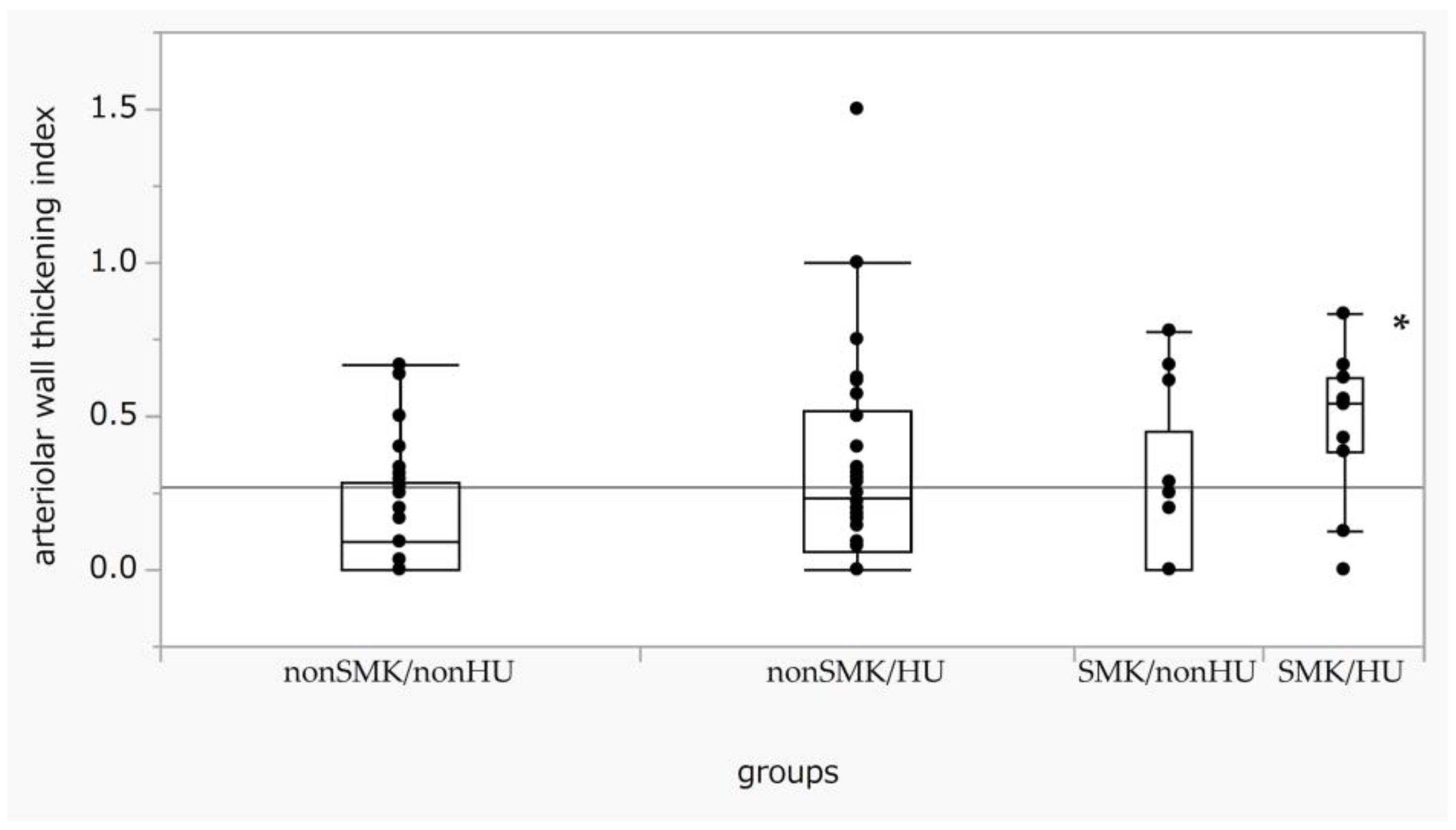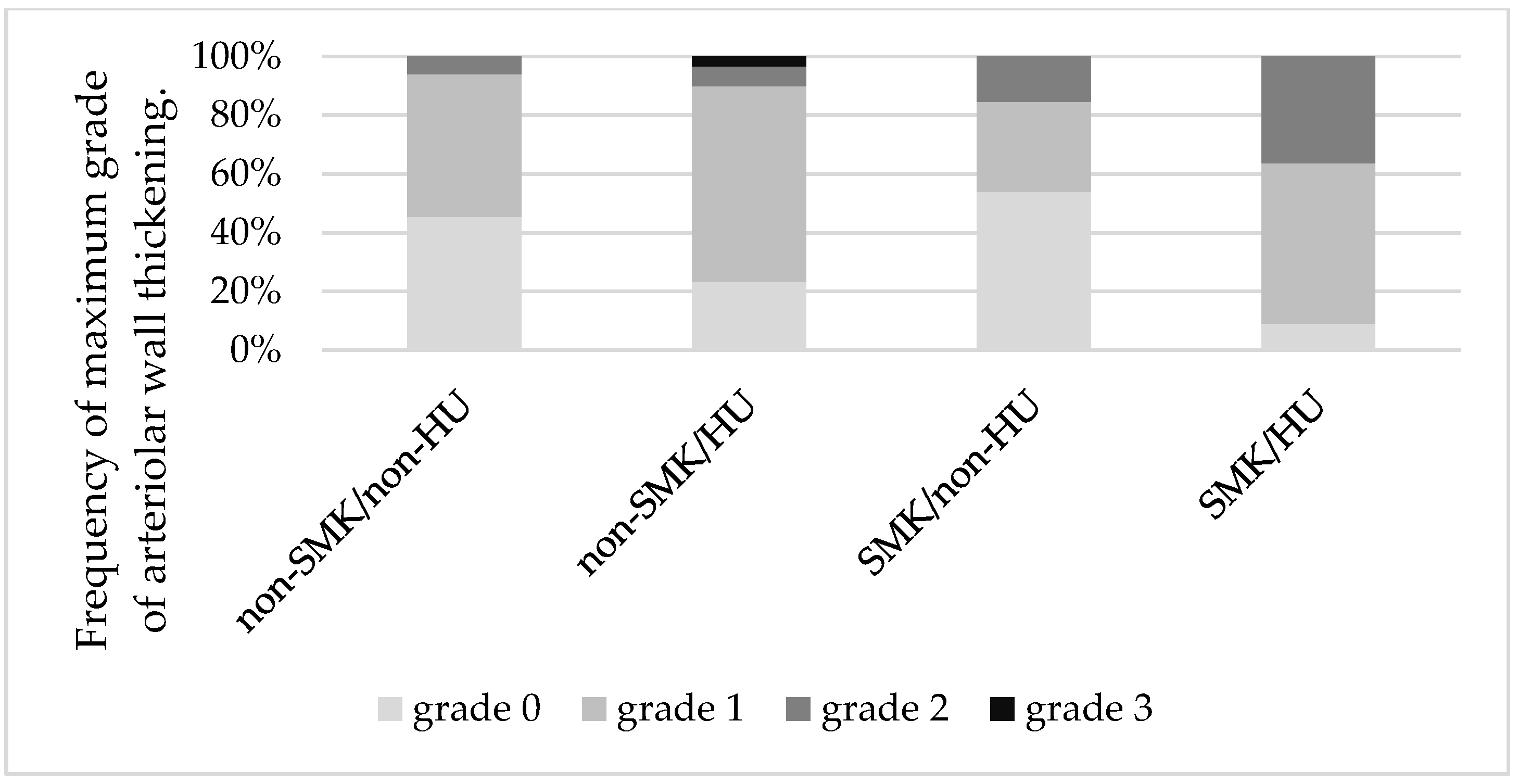The Association of Smoking and Hyperuricemia with Renal Arteriolosclerosis in IgA Nephropathy
Abstract
1. Introduction
2. Materials and Methods
2.1. Settings and Participants
2.2. Semiquantitative Assessment of Preglomerular Arteriole Damage
2.3. Association of Uric Acid (UA) Levels and Renal Arteriolar Hyalinosis According to SMK Status
2.4. Statistical Analysis
3. Results
3.1. Hyalinosis Index and Rate of Max Grade of Hyalinosis among the Subgroups
3.2. Wall Thickening Index and Rate of Max Grade of Wall Thickening among the Subgroups
3.3. The Risk of Higher-Grade Arteriolar Hyalinosis and Wall Thickness
4. Discussion
5. Conclusions
Author Contributions
Funding
Institutional Review Board Statement
Informed Consent Statement
Data Availability Statement
Acknowledgments
Conflicts of Interest
References
- Xia, J.; Wang, L.; Ma, Z.; Zhong, L.; Wang, Y.; Gao, Y.; He, L.; Su, X. Cigarette smoking and chronic kidney disease in the general population: A systematic review and meta-analysis of prospective cohort studies. Nephrol. Dial. Transplant. 2017, 32, 475–487. [Google Scholar] [CrossRef]
- Ishizaka, N.; Ishizaka, Y.; Toda, E.-I.; Shimomura, H.; Koike, K.; Seki, G.; Nagai, R.; Yamakado, M. Association between Cigarette Smoking and Chronic Kidney Disease in Japanese Men. Hypertens. Res. 2008, 31, 485–492. [Google Scholar] [CrossRef]
- Barbato, A.; D’elia, L.; Perna, L.; Molisso, A.; Iacone, R.; Strazzullo, P.; Galletti, F. Increased Microalbuminuria Risk in Male Cigarette Smokers: Results from the “Olivetti Heart Study” after 8 Years Follow-Up. Kidney Blood Press. Res. 2019, 44, 33–42. [Google Scholar] [CrossRef]
- Yoon, H.-J.; Park, M.; Yoon, H.; Son, K.-Y.; Cho, B.; Kim, S. The differential effect of cigarette smoking on glomerular filtration rate and proteinuria in an apparently healthy population. Hypertens. Res. 2009, 32, 214–219. [Google Scholar] [CrossRef]
- Ishani, A.; Grandits, G.A.; Grimm, R.H.; Svendsen, K.H.; Collins, A.J.; Prineas, R.J.; Neaton, J.D. Association of Single Measurements of Dipstick Proteinuria, Estimated Glomerular Filtration Rate, and Hematocrit with 25-Year Incidence of End-Stage Renal Disease in the Multiple Risk Factor Intervention Trial. J. Am. Soc. Nephrol. 2006, 17, 1444–1452. [Google Scholar] [CrossRef]
- Yamagata, K.; Ishida, K.; Sairenchi, T.; Takahashi, H.; Ohba, S.; Shiigai, T.; Narita, M.; Koyama, A. Risk factors for chronic kidney disease in a community-based population: A 10-year follow-up study. Kidney Int. 2007, 71, 159–166. [Google Scholar] [CrossRef]
- Vupputuri, S.; Sandler, D.P. Lifestyle risk factors and chronic kidney disease. Ann. Epidemiol. 2003, 13, 712–720. [Google Scholar] [CrossRef]
- Verhave, J.C.; Hillege, H.L.; Burgerhof, J.G.; Gansevoort, R.T.; De Zeeuw, D.; De Jong, P.E. The association between atherosclerotic risk factors and renal function in the general population. Kidney Int. 2005, 67, 1967–1973. [Google Scholar] [CrossRef]
- Wang, S.; Qin, A.; Pei, G.; Jiang, Z.; Dong, L.; Tan, J.; Tan, L.; Tang, Y.; Qin, W. Cigarette smoking may accelerate the progression of IgA nephropathy. BMC Nephrol. 2021, 22, 239. [Google Scholar] [CrossRef]
- Huang, P.P.; Shu, D.H.; Su, Z.; Luo, S.N.; Xu, F.F.; Lin, F. Association between lifestyle, gender and risk for developing end-stage renal failure in IgA nephropathy: A case-control study within 10 years. Ren. Fail. 2019, 41, 914–920. [Google Scholar] [CrossRef]
- Orth, S.R.; Hallan, S.I. Smoking: A risk factor for progression of chronic kidney disease and for cardiovascular morbidity and mortality in renal patients—Absence of evidence or evidence of absence? Clin. J. Am. Soc. Nephrol. 2008, 3, 226–236. [Google Scholar] [CrossRef]
- Baggio, B.; Budakovic, A.; Casara, D.; Gambaro, G.; Saladini, G.; Piccoli, A.; Verlato, F. Renal involvement in subjects with peripheral atherosclerosis. J. Nephrol. 2001, 14, 286–292. [Google Scholar]
- Ejerblad, E.; Fored, C.M.; Lindblad, P.; Fryzek, J.; Dickman, P.W.; Elinder, C.-G.; McLaughlin, J.K.; Nyrén, O. Association between Smoking and Chronic Renal Failure in a Nationwide Population-Based Case-Control Study. J. Am. Soc. Nephrol. 2004, 15, 2178–2185. [Google Scholar] [CrossRef]
- Liang, K.V.; Greene, E.L.; Oei, L.S.; Lewin, M.; Lager, D.; Sethi, S. Nodular Glomerulosclerosis: Renal Lesions in Chronic Smokers Mimic Chronic Thrombotic Microangiopathy and Hypertensive Lesions. Am. J. Kidney Dis. 2007, 49, 552–559. [Google Scholar] [CrossRef]
- Zitt, N.; Kollerits, B.; Neyer, U.; Mark, W.; Heininger, D.; Mayer, G.; Kronenberg, F.; Lhotta, K. Cigarette smoking and chronic allograft nephropathy. Nephrol. Dial. Transplant. 2007, 22, 3034–3039. [Google Scholar] [CrossRef]
- Zamami, R.; Kohagura, K.; Miyagi, T.; Kinjyo, T.; Shiota, K.; Ohya, Y. Modification of the impact of hypertension on proteinuria by renal arteriolar hyalinosis in nonnephrotic chronic kidney disease. J. Hypertens. 2016, 34, 2274–2279. [Google Scholar] [CrossRef]
- Cha, Y.J.; Lim, B.J.; Kim, B.S.; Kim, Y.; Yoo, T.-H.; Han, S.H.; Kang, S.-W.; Choi, K.H.; Jeong, H.J. Smoking-Related Renal Histologic Injury in IgA Nephropathy Patients. Yonsei Med. J. 2016, 57, 209–216. [Google Scholar] [CrossRef]
- Mazzali, M.; Kanellis, J.; Han, L.; Feng, L.; Xia, Y.-Y.; Chen, Q.; Kang, D.-H.; Gordon, K.L.; Watanabe, S.; Nakagawa, T.; et al. Hyperuricemia induces a primary renal arteriolopathy in rats by a blood pressure-independent mechanism. Am. J. Physiol. Ren. Physiol. 2002, 282, F991–F997. [Google Scholar] [CrossRef]
- Kohagura, K.; Kochi, M.; Miyagi, T.; Kinjyo, T.; Maehara, Y.; Nagahama, K.; Sakima, A.; Iseki, K.; Ohya, Y. An association between uric acid levels and renal arteriolopathy in chronic kidney disease: A biopsy-based study. Hypertens. Res. 2013, 36, 43–49. [Google Scholar] [CrossRef]
- Orth, S.R. Smoking and the Kidney. J. Am. Soc. Nephrol. 2002, 13, 1663–1672. [Google Scholar] [CrossRef]
- Johnson, R.J.; Bakris, G.L.; Borghi, C.; Chonchol, M.B.; Feldman, D.; Lanaspa, M.A.; Merriman, T.R.; Moe, O.W.; Mount, D.B.; Lozada, L.G.S.; et al. Hyperuricemia, Acute and Chronic Kidney Disease, Hypertension, and Cardiovascular Disease: Report of a Scientific Workshop Organized by the National Kidney Foundation. Am. J. Kidney Dis. 2018, 71, 851–865. [Google Scholar] [CrossRef]
- Matsuo, S.; Imai, E.; Horio, M.; Yasuda, Y.; Tomita, K.; Nitta, K.; Yamagata, K.; Tomino, Y.; Yokoyama, H.; Hishida, A.; et al. Revised Equations for Estimated GFR From Serum Creatinine in Japan. Am. J. Kidney Dis. 2009, 53, 982–992. [Google Scholar] [CrossRef]
- Rizzoni, D.; Rosei, E.A. Small artery remodeling in diabetes mellitus. Nutr. Metab. Cardiovasc. Dis. 2009, 19, 587–592. [Google Scholar] [CrossRef]
- Agabiti-Rosei, E.; Heagerty, A.M.; Rizzoni, D. Effects of antihypertensive treatment on small artery remodelling. J. Hypertens. 2009, 27, 1107–1114. [Google Scholar] [CrossRef]
- Baggio, B.; Budakovic, A.; Perissinotto, E.; Maggi, S.; Cantaro, S.; Enzi, G.; Grigoletto, F.; ILSA Working Group. Atherosclerotic risk factors and renal function in the elderly: The role of hyperfibrinogenaemia and smoking. Results from the Italian Longitudinal Study on Ageing (ILSA). Nephrol. Dial. Transplant. 2005, 20, 114–123. [Google Scholar] [CrossRef]
- Haroun, M.K.; Jaar, B.G.; Hoffman, S.C.; Comstock, G.W.; Klag, M.J.; Coresh, J. Risk factors for chronic kidney disease: A prospective study of 23,534 men and women in Washington County, Maryland. J. Am. Soc. Nephrol. 2003, 14, 2934–2941. [Google Scholar] [CrossRef]
- Bleyer, A.J.; Shemanski, L.R.; Burke, G.L.; Hansen, K.J.; Appel, R.G. Tobacco, hypertension, and vascular disease: Risk factors for renal functional decline in an older population. Kidney Int. 2000, 57, 2072–2079. [Google Scholar] [CrossRef]
- Wesson, D.E. The relationship of cigarette smoking to end-stage renal disease. Semin. Nephrol. 2003, 23, 317–322. [Google Scholar] [CrossRef]
- Jones-Burton, C.; Seliger, S.L.; Scherer, R.W.; Mishra, S.I.; Vessal, G.; Brown, J.; Weir, M.R.; Fink, J.C. Cigarette Smoking and Incident Chronic Kidney Disease: A Systematic Review. Am. J. Nephrol. 2007, 27, 342–351. [Google Scholar] [CrossRef]
- Kanamitsu, T.; Kohagura, K.; Zamami, R.; Nakamura, T.; Oshiro, N.; Miyagi, T.; Nakamura, K.; Ohya, Y. Association of urinary angiotensinogen with renal arteriolar remodeling in chronic kidney disease. J. Hypertens. 2022, 40, 650–657. [Google Scholar] [CrossRef]
- Griffin, K.A. Hypertensive Kidney Injury and the Progression of Chronic Kidney Disease. Hypertension 2017, 70, 687–694. [Google Scholar] [CrossRef]
- Nangaku, M. Chronic Hypoxia and Tubulointerstitial Injury: A final common pathway to end-stage renal failure. J. Am. Soc. Nephrol. 2006, 17, 17–25. [Google Scholar] [CrossRef]
- Nagasawa, Y.; Yamamoto, R.; Rakugi, H.; Isaka, Y. Cigarette smoking and chronic kidney diseases. Hypertens. Res. 2012, 35, 261–265. [Google Scholar] [CrossRef]
- Gambaro, G.; Verlato, F.; Budakovic, A.; Casara, D.; Saladini, G.; Del Prete, D.; Bertaglia, G.; Masiero, M.; Checchetto, S.; Baggio, B. Renal impairment in chronic cigarette smokers. J. Am. Soc. Nephrol. 1998, 9, 562–567. [Google Scholar] [CrossRef]
- Kubo, M.; Kiyohara, Y.; Kato, I.; Tanizaki, Y.; Katafuchi, R.; Hirakata, H.; Okuda, S.; Tsuneyoshi, M.; Sueishi, K.; Fujishima, M.; et al. Risk factors for renal glomerular and vascular changes in an autopsy-based population survey: The Hisayama Study. Kidney Int. 2003, 63, 1508–1515. [Google Scholar] [CrossRef]
- Kang, D.-H.; Ha, S.-K. Uric Acid Puzzle: Dual Role as Anti-oxidantand Pro-oxidant. Electrolytes Blood Press. 2014, 12, 1–6. [Google Scholar] [CrossRef]
- Kojima, S.; Uchiyama, K.; Yokota, N.; Tokutake, E.; Wakasa, Y.; Hiramitsu, S.; Waki, M.; Jinnouchi, H.; Kakuda, H.; Hayashi, T.; et al. Optimal uric acid levels by febuxostat treatment and cerebral, cardiorenovascular risks: Post hoc analysis of a randomized controlled trial. Rheumatology 2022, 61, 2346–2359. [Google Scholar] [CrossRef]




| Non-SMK | SMK | p-Value | |||
|---|---|---|---|---|---|
| non-HU n = 33 | HU n = 30 | non-HU n = 13 | HU n = 11 | ||
| Men Age (years) BMI (kg/m2) Diabetes mellitus Hypertension Dyslipidemia Systolic blood pressure (mmHg) Diastolic blood pressure (mmHg) Proteinuria (g/g creatinine) Serum creatinine (mg/dL) Estimated GFR (mL/min/1.73 m2) Serum uric acid (mg/dL) LDL cholesterol (mg/dL) HDL cholesterol (mg/dL) Renal arteriolar hyalinosis, number (%) Renal arteriolar hyalinosis index Diuretics Renin–angiotensin system inhibitors Statins | 14 (42) 30 (20–38) 21 (19–23) 1 (3) 5 (15) 7 (21) 120 (110–127) 72 (66–79) 0.63 (0.24–1.1) 0.66 (0.60–0.83) 93.8 (83.2−116) 4.7 (4.2−5.7) 102 (84−127) 60 (49−71) 11 (33) 0 (0−0.2) 0 (0) 7 (21) 0 (0) | 6 (20) 32 (22−51) 22 (21−26) 3 (10) 9 (30) 12 (40) 112 (106−129) 70 (68−77) 0.82 (0.39−1.6) 0.68 (0.53−0.93) 85.1 (53.6−124) 6.3 (5.6−7.0) 109 (90−125) 56 (48−71) 21 (70) 0.1 (0−1) 2 (7) 6 (20) 1 (3) | 13 (100) 24 (19−52) 23 (19−26) 1 (8) 4 (31) 7 (54) 120 (113−130) 74 (71−82) 0.6 (0.30−1.2) 0.74 (0.71−0.91) 102 (72−119) 6.3 (5.7−6.8) 102 (71−126) 54 (40−67) 6 (46) 0.1 (0−0.4) 0 (0) 4 (31) 2 (15) | 8 (72) 49 (38−59) 26 (23−30) 2 (18) 6 (55) 7 (64) 130 (114−138) 80 (70−80) 0.75 (0.49−1.6) 0.88 (0.81−1.2) 69.3 (48.5−90.9) 7.5 (7.1−8.0) 112 (87−130) 49 (40−64) 9 (82) 1.2 (0.3−1.5) 0 (0) 3 (27) 1 (9) | <0.0001 0.02 0.003 0.1884 0.0203 0.0342 0.1713 0.4006 0.2550 0.0129 0.04006 <0.0001 0.723 0.428 0.0058 0.0002 0.2737 0.8569 0.1297 |
| Model 1 | Model 2 | Model 3 | |
|---|---|---|---|
| OR (95% CI) | OR (95% CI) | OR (95% CI) | |
| non-SMK/non-HU | 1.00 (reference) | 1.00 (reference) | 1.00 (reference) |
| non-SMK/ HU | 5.60 * (1.26–24.9) | 6.10 * (1.07–34.7) | 7.62 * (1.17–49.5) |
| SMK/non-HU | 0.51 (0.07–4.07) | 0.43 (0.04–4.40) | 0.57 (0.06–5.70) |
| SMK/HU | 4.85 (0.72–32.7) | 4.53 (0.57–37.0) | 6.13 (0.64–58.3) |
| Model 1 | Model 2 | Model 3 | |
|---|---|---|---|
| OR (95% CI) | OR (95% CI) | OR (95% CI) | |
| non-SMK/non-HU | 1.00 (reference) | 1.00 (reference) | 1.00 (reference) |
| non-SMK/HU | 1.77(0.49–6.40) | 0.99 (0.23–4.28) | 1.12 (0.25–5.08) |
| SMK/non-HU | 1.42 (0.20–10.2) | 1.5 (0.16–13.9) | 2.11 (0.21–20.9) |
| SMK/HU | 13.0 * (1.77–95.1) | 10.2 * (1.19–88.0) | 12.8 * (1.36–119) |
Disclaimer/Publisher’s Note: The statements, opinions and data contained in all publications are solely those of the individual author(s) and contributor(s) and not of MDPI and/or the editor(s). MDPI and/or the editor(s) disclaim responsibility for any injury to people or property resulting from any ideas, methods, instructions or products referred to in the content. |
© 2023 by the authors. Licensee MDPI, Basel, Switzerland. This article is an open access article distributed under the terms and conditions of the Creative Commons Attribution (CC BY) license (https://creativecommons.org/licenses/by/4.0/).
Share and Cite
Shinzato, Y.; Zamami, R.; Oshiro, N.; Nakamura, T.; Ishida, A.; Ohya, Y.; Kohagura, K. The Association of Smoking and Hyperuricemia with Renal Arteriolosclerosis in IgA Nephropathy. Biomedicines 2023, 11, 2053. https://doi.org/10.3390/biomedicines11072053
Shinzato Y, Zamami R, Oshiro N, Nakamura T, Ishida A, Ohya Y, Kohagura K. The Association of Smoking and Hyperuricemia with Renal Arteriolosclerosis in IgA Nephropathy. Biomedicines. 2023; 11(7):2053. https://doi.org/10.3390/biomedicines11072053
Chicago/Turabian StyleShinzato, Yuki, Ryo Zamami, Nanako Oshiro, Takuto Nakamura, Akio Ishida, Yusuke Ohya, and Kentaro Kohagura. 2023. "The Association of Smoking and Hyperuricemia with Renal Arteriolosclerosis in IgA Nephropathy" Biomedicines 11, no. 7: 2053. https://doi.org/10.3390/biomedicines11072053
APA StyleShinzato, Y., Zamami, R., Oshiro, N., Nakamura, T., Ishida, A., Ohya, Y., & Kohagura, K. (2023). The Association of Smoking and Hyperuricemia with Renal Arteriolosclerosis in IgA Nephropathy. Biomedicines, 11(7), 2053. https://doi.org/10.3390/biomedicines11072053






